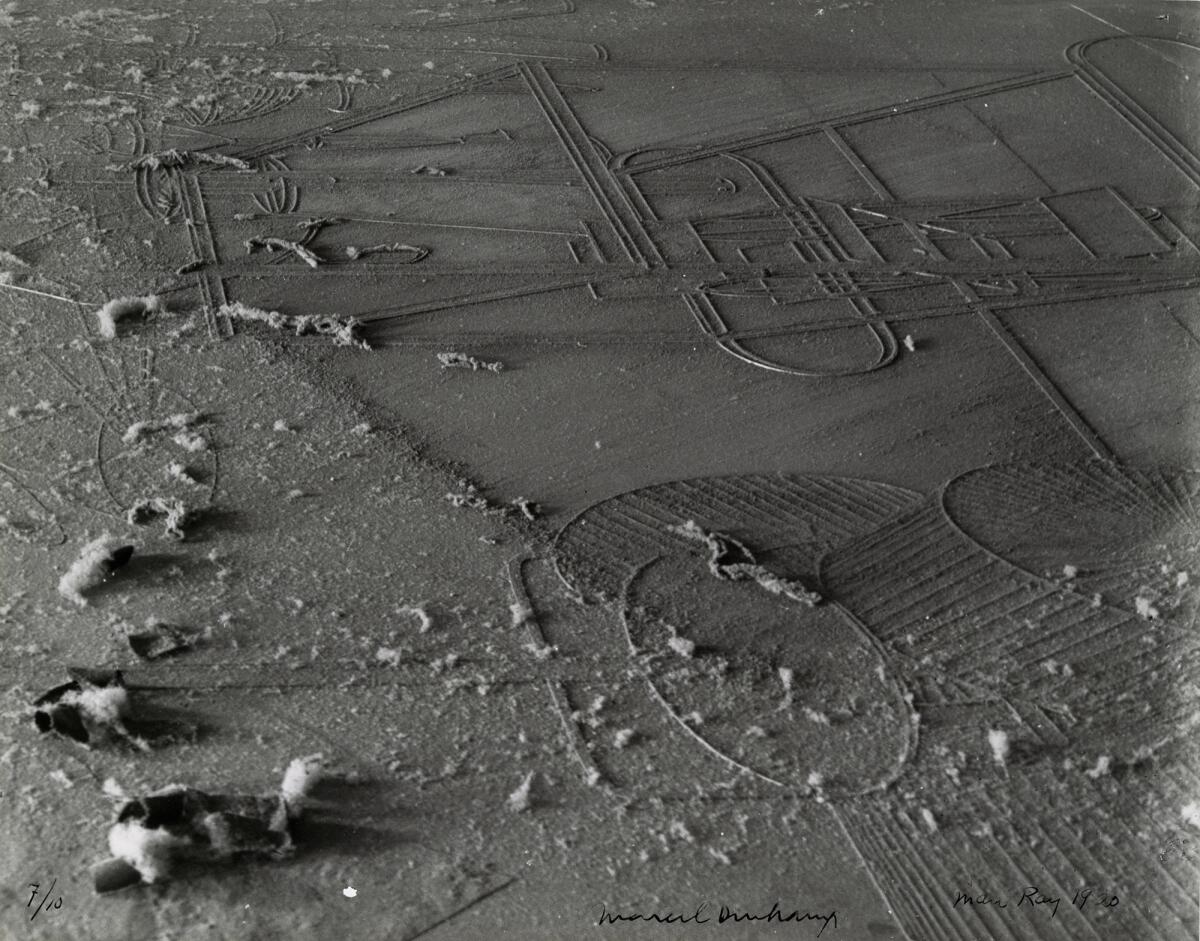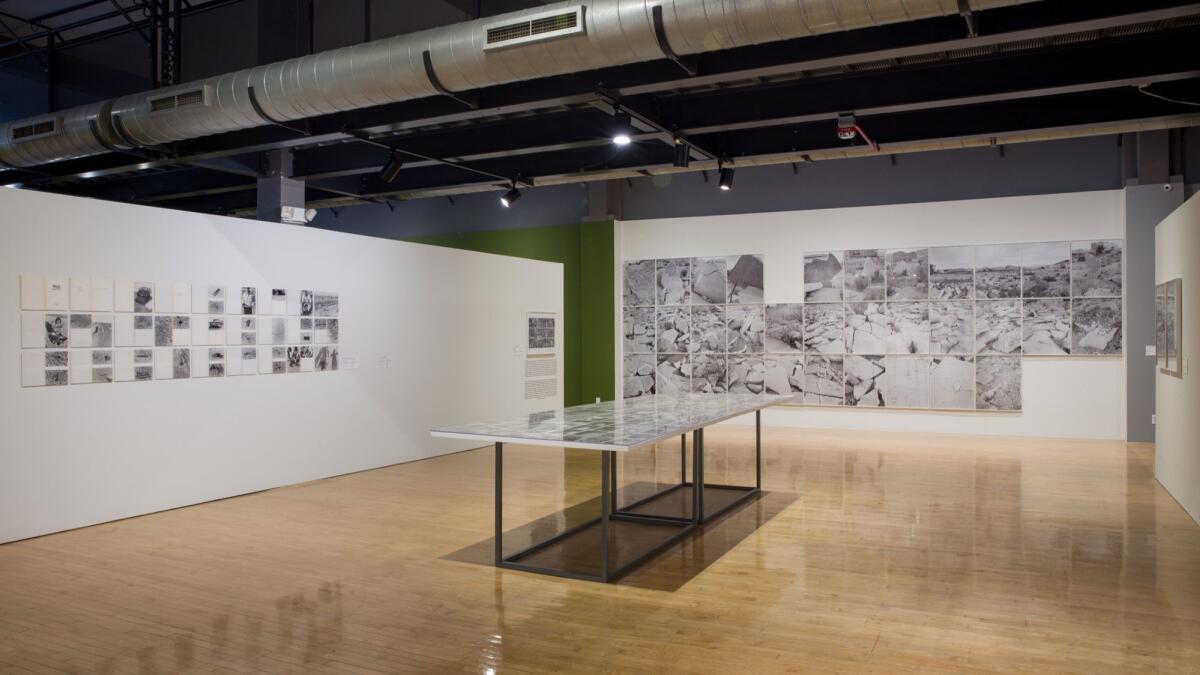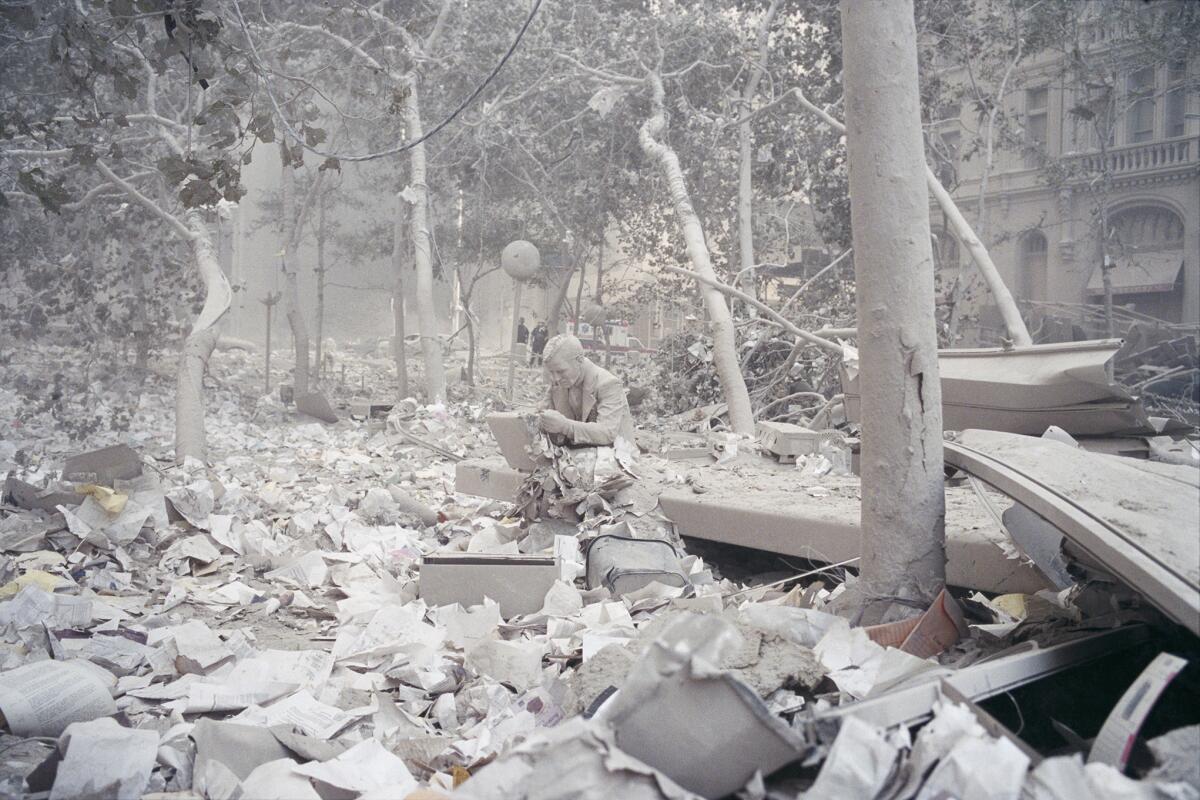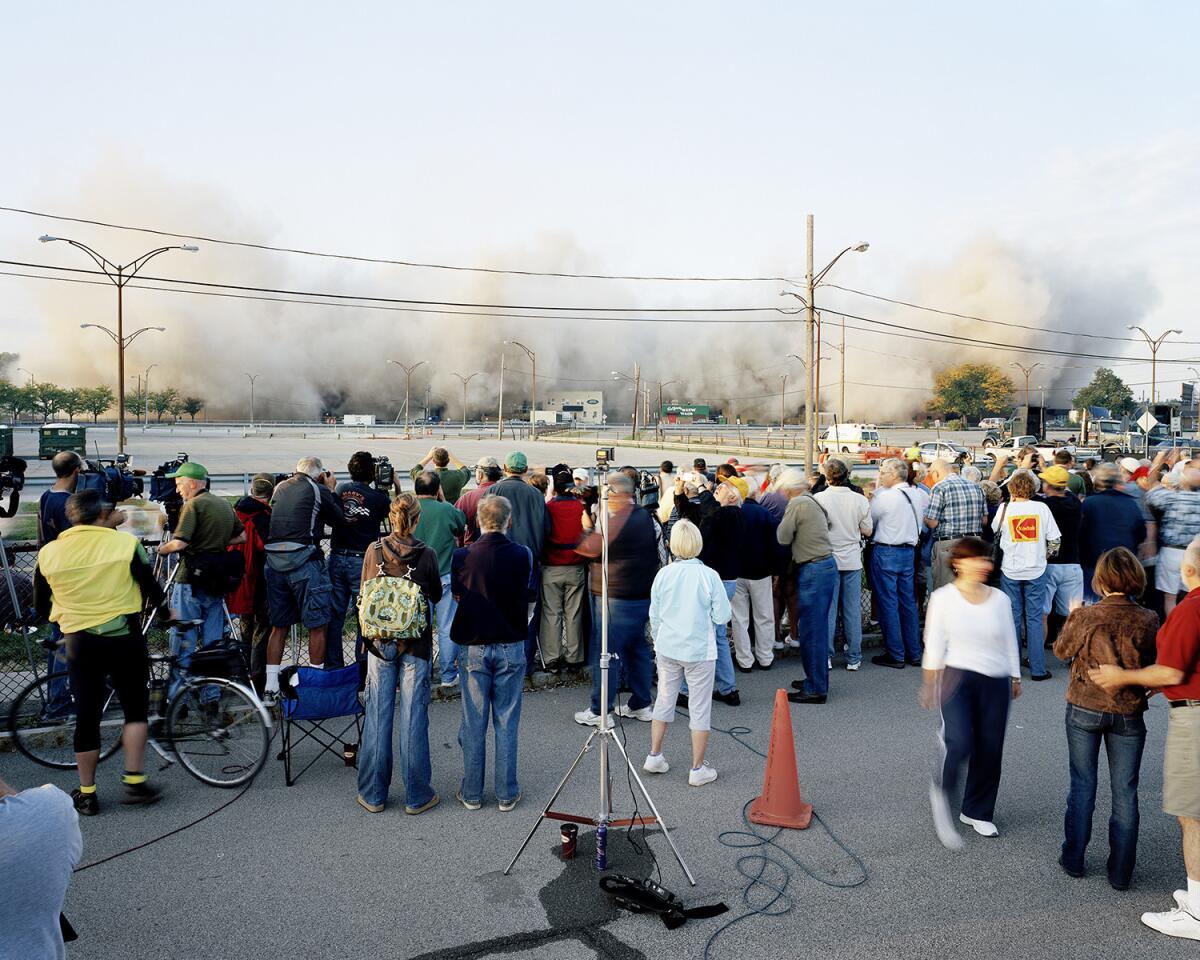Review: Contemplating ‘a Handful of Dust’ at the California Museum of Photography
- Share via
Dust would not seem to have much potential as an aesthetic device, but it nonetheless anchors an unusual show at the California Museum of Photography in Riverside. Inevitable decay and total ruin are the motif – ashes to ashes, so to speak – with photography as the instrument both analog and digital. The calamitous 20th century looms as the bigger crumbling picture.
“a Handful of Dust: from the Cosmic to the Domestic” is a kind of rhapsodic (if often dour) visual tone-poem to those tiny particles of ordinary grit. The title’s unusual typography is the first clue to the traveling show’s expressive intent.
Rather than a conventional art-historical analysis, London-based independent curator David Campany gives us stream-of-consciousness connections between and among the more than 60 works. Two images flanking the show’s entry set his theatrical stage.
It starts with Surrealist photographer Man Ray and Dadaist Marcel Duchamp. In 1920, the two 30-something artists produced a now well-known photograph of the transparent glass surface of a sculpture on which Duchamp worked for nearly eight years. During production, Duchamp left the supporting sheet of glass by an open window at his Broadway studio on New York’s Upper West Side, near what is today Lincoln Center. Over many months, a layer of grimy dust settled on it.

Man Ray photographed the dusty glass, down low and at a raking angle. The image looks almost abstract.
When unveiled a few years later, the picture was cheekily titled “View from an Aeroplane.” (It would later be dubbed “Dust Breeding.”) The flat, tilted image features an obscure pattern of straight and curved geometric lines, dotted with organic gray clumps. At first glance, it does indeed look like an aerial landscape view, taken while flying over plowed farmland, an industrial park or maybe the mysterious Nazca lines of Peru.
A mural-size blowup of the picture is to the entry’s right. Greatly enlarged, the size indicates two things: photographs are physically malleable, and Duchamp’s influence on art is big.
To the entry’s left is something different – a 1980 commercial image from an advertisement for a can of dust-off cleaner. The compressed-air product, introduced a decade before, was useful for removing dust from photography equipment and film without having to touch the surface of a negative or camera lens.
When the ad ran, the product’s use was rapidly expanding in response to the rise of personal computers. A blast of canned cleaner could rid screens, keyboards and CPU fans of damaging dust and lint. Tension between old technology and new is established as an exhibition subtext.
The entrance juxtaposition also seems determined to blow some of the accumulated critical dust off of Duchamp’s enigmatic sculpture. “The Bride Stripped Bare by Her Bachelors, Even (The Large Glass),” fractionally depicted in Man Ray’s photo, is a comical construction. Supposedly, it diagrams an erotic encounter between humanity and industrial machinery, metaphorically meditating on the unprecedented absurdity of the modern world.
The sober exhibition could use a bit more of that Dada levity. You can tell it is serious-minded because, with just a few exceptions, all the images in it are black-and-white. Those are the colors of text printed on paper, the academic palette of the library and research department. Mostly absent are the liberating capacities of irrational chromatic reveries like hot pink, lime green or mauve.


Aerial surveillance views of post-atomic Hiroshima and Nagasaki record scenes of astonishing devastation. Anonymous photojournalism chronicles the ravaging American Dust Bowl of the 1930s. Nearby, a news photograph of the stored roadster once owned by Benito Mussolini, Italy’s lynched fascist dictator, presents a modern chariot covered in a layer of dust.
A photograph by Jeff Mermelstein shows a mundane public sculpture of a businessman shrouded in ash from the aftermath of the Sept. 11, 2001 attacks. The sight echoes against Giorgio Sommer’s 1873 documentary picture of a plaster cast of a victim of Mount Vesuvius’ eruption nearly 2,000 years ago.
In Aaron Siskind’s 1949 photographic close-up of a wall at an anonymous Arizona building, paint peels and crumbles. Formally, the work is little different from another Siskind picture made 22 years later, this one showing a close-up of tattered handbills peeling off a wall in San Luis Potosi, Mexico. Time and space collapse.
Many other familiar works of art are included. The photo book “Royal Road Test” by Ed Ruscha, Mason Williams and Patrick Blackwell charts the banged-up fate of a typewriter hurled from a speeding convertible in the barren Mojave desert. A single gray painting is recorded in 128 Gerhard Richter photographs laid out on a tabletop, facilitating farcical study. John Divola’s gritty pictures show the graffiti-sprayed interiors of an abandoned house.
Less well-known but certainly haunting is “Murmur,” a looped, seven-minute video projection by British artist Kirk Palmer. Wind eerily rustles trees in a dense, hilly Japanese landscape. Animism, the attribution of a soul to natural phenomena, is central to Shinto religion; also evoked is a chilling intimation of impending doom.
Nature bites back.
The show’s primary jolt of color comes in several gallery walls painted forest green – a landscape association, I’d guess – amid more standard contemporary museum walls of white and gray. Image overload is the terrain of modern life, a forest of signs unlike any other encountered in world history.


Roland Barthes’ 1980 book “Camera Lucida,” his only full-scale meditation on photography, could serve as back-story to the exhibition. The French literary theorist and philosopher insisted that the essence of the medium will be found in its implied message: Because a photograph, unlike a painting, is “never distinguished from its referent (from what it represents),” the image is an inevitable record of the past – of a moment gone, a context lost and an experience irrecoverable. Death is the implied message, regardless of the person, place or thing in the picture.
Barthes being Barthes, he laid out his claim in an almost novelistic way. His mother had recently died, and her passing was intertwined with his musings on camera work. In “a Handful of Dust,” something of that terminal quality reverberates through an arresting Robert Burley work – one of the show’s few color photographs.
A crowd has gathered to watch the 2007 implosion of two Kodak film production factories in Rochester, N.Y. The once-titanic business was felled by the rise of digital culture, in which film stock is superfluous. Since Kodak employees are surely among the throng of witnesses to the implosion, the photograph creates a dizzying conceptual loop. The crowds lift cellphones, video and digital cameras to capture souvenir pictures of the destruction of their own way of life.
Sometimes, dust amounts to more than just a handful.
UCR California Museum of Photography, 3824 + 3834 Main St., Riverside; (951) 827-4787, through Dec. 9. Closed Monday. artsblock.ucr.edu/
Twitter: @KnightLAT
The biggest entertainment stories
Get our big stories about Hollywood, film, television, music, arts, culture and more right in your inbox as soon as they publish.
You may occasionally receive promotional content from the Los Angeles Times.








